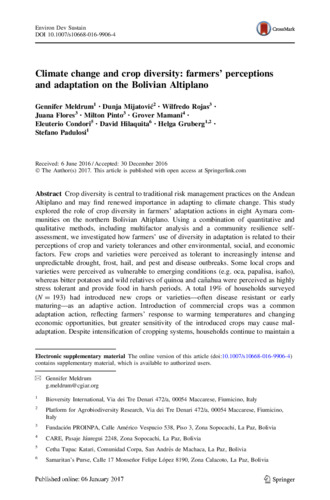Climate change and crop diversity: farmers’ perceptions and adaptation on the Bolivian Altiplano
Crop diversity is central to traditional risk management practices on the Andean Altiplano and may find renewed importance in adapting to climate change. This study explored the role of crop diversity in farmers’ adaptation actions in eight Aymara communities on the northern Bolivian Altiplano. Using a combination of quantitative and qualitative methods, including multifactor analysis and a community resilience self-assessment, we investigated how farmers’ use of diversity in adaptation is related to their perceptions of crop and variety tolerances and other environmental, social, and economic factors. Few crops and varieties were perceived as tolerant to increasingly intense and unpredictable drought, frost, hail, and pest and disease outbreaks. Some local crops and varieties were perceived as vulnerable to emerging conditions (e.g. oca, papalisa, isaño), whereas bitter potatoes and wild relatives of quinoa and cañahua were perceived as highly stress tolerant and provide food in harsh periods. A total 19% of households surveyed (N = 193) had introduced new crops or varieties—often disease resistant or early maturing—as an adaptive action. Introduction of commercial crops was a common adaptation action, reflecting farmers’ response to warming temperatures and changing economic opportunities, but greater sensitivity of the introduced crops may cause maladaptation. Despite intensification of cropping systems, households continue to maintain a median four potato varieties with different tolerance traits, yet this risk management practice was not perceived as adaptation. Strengthening resilience will require a combination of actions, including maintaining and expanding crop portfolios and restoring soil and ecosystem health, using both traditional and innovative approaches.

